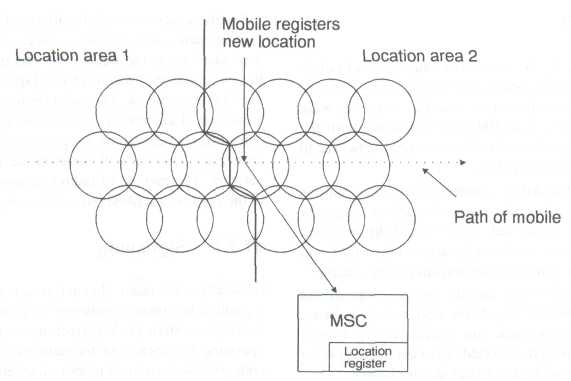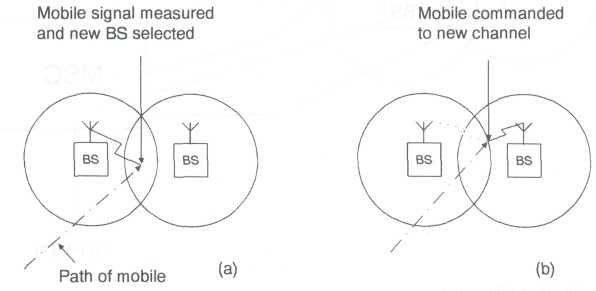
- •47 Cellular radio systems
- •47.1 Introduction
- •47.2 Principles of operation
- •47.2.1 Network configuration
- •47.2.2 Signalling
- •47.2.3 Location registration
- •47.2.4 Call set up
- •47.2.6 Power control
- •47.3 Radio planning
- •47.3.1 Cell repeat patterns
- •47.3.3 Radio propagation
- •47.3.4 Practical radio planning
- •47.3.5 Adding capacity
- •47.4 Overview of systems
- •47.4.2 Tacs
- •47.5 Detailed description of gsm
- •47.5.1 Gsm architecture
- •47.5.2 Air interface
- •47.5.3 Speech coding and channel coding
- •47.5.4 Gsm signalling
- •47.5.5 Security features
- •47.5.6 Gsm services and features
- •47.5.7 Roaming
- •47.6 Services
- •47.6.1 Supplementary services
- •47.6.2 Value added services
- •47.6.3 Data services
- •47.7 Future developments
- •47.7.1 Microcells
- •47.7.2 Intelligent networks
- •47.7.3 Personal communications
- •47.8 Conclusion
47.2.3 Location registration
When a mobile is not engaged in a call, it tunes to the signalling channel of the cell in which it is located and monitors the L-M signalling information. As the mobile moves around the network, from time to time it will need to retune to the signalling channel of another cell when the signal from the current cell falls below an acceptable threshold.
When the mobile retunes in this way, it reads the overhead information broadcast by the new cell and updates the operating parameters as necessary. It also checks the location information being broadcast by the new cell and, if this differs from the previous cell, the mobile automatically informs the network of its new location by means of an interchange on the signalling channel (Figure 47.2). By means of this location registration procedure, the network is able to keep updated a database of the location area of all mobiles. This information is used in the call setup procedure for land to mobile calls.

Figure 47.2 Mobile location registration
47.2.4 Call set up
The signalling procedures for mobile to land (M-L) and land to mobile (L-M) call set up depend upon the technical standard of the particular network. However the general procedure described below holds true for many networks. When the user wishes to make a call, the telephone number to be called is entered followed by a 'call initiation' key (eg pressing the SEND button).
The mobile will transmit an access request to the network on the M-L signalling channel; this may be preceded by the mobile rescanning to ensure it is operating on the signalling channel of the nearest base station. If the network can process the call the base station will send a voice channel allocation message which commands the mobile to switch to a designated voice channel, namely one of the channels allocated to that cell. The mobile retunes to the channel indicated and the network proceeds to set up the call to the desired number. As part of the call set up procedure, the network will validate the mobile requesting the call to ensure that it is a legitimate customer. Many networks incorporate specific security features to carry out this validation.
When the network receives a call for a mobile (eg from the PSTN) it will first check the location database to determine in which location area the mobile last registered. Paging calls to the mobile are transmitted on the L-M signalling channels of all the base stations in the identified location area and a response from the mobile awaited. If the mobile is turned on and receives the paging call it will acknowledge to its nearest base station on the M-L signalling channel. The base station receiving the acknowledgement sends a voice channel allocation message to the mobile and informs the network so that the two halves of the call can be connected.

Figure 47.3 In-call handover
47.2.5 In-call handover
At all times during a call (whether L-M or M-L) the base station currently serving the mobile monitors the signal (strength and/or quality) from the mobile. If the signal falls below a predesignated threshold, the network will command neighbouring base stations to measure the signal from the mobile (Figure 47.3(a)). If another base station is receiving the mobile with a stronger signal than the current base station, a signalling message is sent to the mobile on the voice channel from the current base station commanding the mobile to a new voice channel, namely a free voice channel from those allocated to the neighbouring cell. The mobile changes frequency (and thereby the serving base station) and simultaneously the network connects the call to the new base station (Figure 47.3(b)).
The measuring process and new cell selection may take several seconds, but the user will only be aware of a brief break in transmission as the mobile tunes to the new voice channel.
